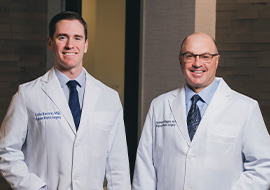Common Questions
How long does it take to heal after surgery?
Following surgery, cold compresses (ice packs) and a topical antibiotic ointment are applied for 3 to 4 days followed by warm compresses. Eye patches are not required. Discomfort is usually minimal and is typically handled by acetaminophen (Tylenol®). Aspirin containing compounds and non-steroidal anti-inflammatory products (Advil, Ibuprofen, etc.) should be avoided 1 weeks prior to surgery and a few days following surgery. Most individuals will have swelling and some degree of bruising that will gradually improve over the first 1 to 3 weeks. Swelling make take weeks or months to completely resolve. Patient healing is variable with some individuals healing much quicker than others. Makeup can be applied to help hide residual bruising, usually starting two weeks after surgery.
For upper eyelid blepharoplasty, 3-4 days off work is average while up to 8 to 10 days may be best for those patients having both an upper and lower eyelid blepharoplasty. Patient's with occupations requiring minimal physical activity may return to work sooner. Patients may have diminished blinking and incomplete eyelid closure following eyelid surgery, particularly ptosis repair. Frequent ocular lubrication may be required for several weeks or months after eyelid surgery. Contact lens wear is typically avoided during the first 3 weeks after surgery or until adequate blinking and eyelid closure returns. After Surgery Instructions
How long will I be bruised and swollen following my surgery?
The amount of swelling and bruising varies from patient to patient and even from the left and right sides in the same patient. Mild bruising may resolve in 2-4 days, whereas more significant bruising may last 10-14 days. Patients may wish to hold blood thinner medications (such as aspirin, ibuprofen, some arthritis medications, Plavix, Coumadin, etc.) prior to surgery in order to minimize the risk of severe bleeding and bruising. Patients should only modify their medication regimen with the advice of their primary care physician, cardiologist, or other prescribing physician.
Eyelid and facial swelling tends to worsen the first few days following surgery. Ice packs, head elevation, and rest may help minimize swelling. Swelling (edema) will often improve considerably over the first 2-3 weeks after surgery but may take several weeks and even months to completely resolve. Go to Postoperative Care to learn more.
When can I wear make-up, wash my hair, or shower following my surgery?
In most cases, patients may shower the day following surgery. Unless there is a dressing that should remain dry, then the operated areas can get wet. Hair washing can also be performed the day following surgery. if a brow lifting procedure or endoscopic forehead procedure were performed, then care should be taken to avoid scrubbing in the areas of the forehead incisions. Make-up should be avoided for 2-3 weeks near incision sites. Once scabbing and crusting has resolved then make-up may be applied to the operated areas. After Surgery Instructions

More information on Entropion
Entropion
What is Entropion?
Entropion is an inturning of the eyelid margin. When the eyelid turns inward, the eyelashes and skin rub against the eye creating a red, irritated eye sensitive to light and wind. If untreated, corneal infection and scarring may result. It may be unilateral or bilateral. Acquired entropion is classified as spastic (due to eye irritation), involutional (due to aging changes), or cicatricial (due to scarring). Lower eyelid entropion (usually involutional) is much more common than upper eyelid entropion (usually cicatricial).
Acquired Entropion
Involutional entropion is the commonest form of entropion and is generally seen in patients after the 5th decade of life. It is caused by progressive weakness of the supportive structures in the lower eyelid. The tarsal plate (tarsus)is the firm part of the eyelid that gives the eyelid its normal shape. The tarsus is supported by tendons medially and laterally and by a specialized structure (the lower eyelid retractors) from below. With age, these structures develop laxity and stretch resulting in an unstable tarsal plate. As the orbicularis muscle covering the eyelid contracts during eyelid closure, the eyelid margin is rolled in toward the eye resulting in entropion.
Acute Spastic Entropion
Acute spastic entropion is an inturning of the eyelid following irritation of the eye or inflammation. It is most frequently seen following intraocular (cataract and glaucoma) surgery in a patient who has unrecognized or mild involutional (aging) eyelid changes before surgery. The eye inflammation causes sustained squeezing or squinting of the eyelids which causes the eyelid margin to roll inward. Corneal irritation from the eyelashes rubbing against the eye may cause further irritation and inflammation worsening the problem.
Cicatricial Entropion
Cicatricial entropion results from scarring on the conjunctival side (inside) of the lower or upper eyelid. A variety of medical conditions may lead to this form of entropion. Trauma (thermal or chemical), infection, trachoma (Chlamydia), herpes, and ocular cicatricial pemphigoid (OCP) are potential causes of cicatricial entropion.
The Treatment of Entropion
 Watch to learn more about Entropion Surgery
Watch to learn more about Entropion Surgery
Surgery is usually necessary to treat entropion. A temporizing measure that may correct the eyelid malposition is taping the eyelid to evert the lid margin. Surgical tape or the sticky part of a Band-Aid, placed from the lower eyelid to the cheek area, will evert the lid and relieve corneal irritation from the eyelashes. In spastic entropion, taping the eyelid may be all that is needed. Once the inflammatory cause of the entropion is relieved, the eyelid position may be normal. A variety of surgical techniques are utilized to treat entropion. In adults, these surgeries are done under local anesthesia as an outpatient. Dissolvable sutures are preferred and the eyelid typically heals over several weeks to months.
More information on Entropion
